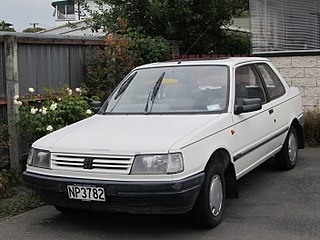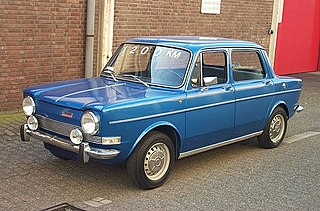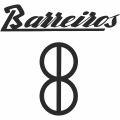Dodge is an American brand of automobiles and a division of Stellantis North America, based in Auburn Hills, Michigan. Dodge vehicles have historically included performance cars, and for much of its existence Dodge was Chrysler's mid-priced brand above Plymouth.

Simca was a French automaker, founded in November 1934 by Fiat S.p.A. and directed from July 1935 to May 1963 by Italian Henri Pigozzi. Simca was affiliated with Fiat and, after Simca bought Ford's French subsidiary, became increasingly controlled by Chrysler. In 1970, Simca became a brand of Chrysler's European business, ending its period as an independent company. Simca disappeared in 1978, when Chrysler divested its European operations to another French automaker, PSA Peugeot Citroën. PSA replaced the Simca brand with Talbot after a short period when some models were badged as Simca-Talbots.

The Rootes Group or Rootes Motors Limited was a British automobile manufacturer and, separately, a major motor distributors and dealers business. Run from London's West End, the manufacturer was based in the Midlands and the distribution and dealers business in the south of England. In the decade beginning 1928 the Rootes brothers, William and Reginald, made prosperous by their very successful distribution and servicing business, were keen to enter manufacturing for closer control of the products they were selling. One brother has been termed the power unit, the other the steering and braking system.

The Peugeot 309 is a small family car that was manufactured between 1985 and 1994 in England, Spain and France by PSA Peugeot Citroën. It was originally intended to be badged as a Talbot and, as development progressed, to be called the Talbot Arizona.

The Hillman Avenger is a rear-wheel drive small family car originally manufactured by the former Rootes division of Chrysler Europe from 1970–1978, badged from 1976 onward as the Chrysler Avenger. Between 1979 and 1981 it was manufactured by PSA Peugeot Citroën and badged as the Talbot Avenger. The Avenger was marketed in North America as the Plymouth Cricket and was the first Plymouth to have a four-cylinder engine since the 1932 Plymouth Model PB was discontinued.

The Dodge Dart is a line of large passenger cars produced by Dodge from the 1959 to 1976 model years in North America, with production extended to later years in various other markets.

The Talbot Horizon is a compact hatchback that was designed by Chrysler Europe and was produced from 1978 to 1987 under the Simca, Chrysler and Talbot nameplates. The successor to both the Simca 1100 and Hillman Avenger, the Horizon adopted a front-wheel drive, transverse-engine layout.

The Talbot Tagora is an executive car developed by Chrysler Europe and produced by Peugeot Société Anonyme (PSA). The Tagora was marketed under the Talbot marque after PSA took over Chrysler's European operations in 1979. PSA presented the first production vehicle in 1980 and launched it commercially in 1981. The Tagora fell short of sales expectations, described as a "showroom flop" just a year after its launch, and PSA cancelled the model two years later. Fewer than 20,000 Tagora models were built, all of them at the former Simca factory in Poissy, near Paris, France.

The Dodge Omni and the nearly identical badge engineered variant, the Plymouth Horizon, is a subcompact car manufactured and marketed by Chrysler Corporation for model years 1978-1990. The first Chrysler model line produced with front-wheel drive, the Omni and Horizon were also the first front-wheel drive economy cars assembled in the United States. Marketed for eleven years with very few changes, around 2,500,000 Omnis and Horizons were manufactured, with the Plymouth variants more popular than the Dodge-branded models.

The Simca 1307 is a large family car produced by Chrysler Europe and subsequently PSA Peugeot Citroën from 1975 to 1986. Codenamed 'C6' in development, the car was styled in the United Kingdom by Roy Axe and his team at Whitley, and the car was engineered by Simca at Poissy in France.

Associated Equipment Company (AEC) was a British vehicle manufacturer that built buses, motorcoaches and trucks from 1912 until 1979. The name Associated Equipment Company was hardly ever used; instead, it traded under the AEC and ACLO brands. During World War One, AEC was the most prolific British lorry manufacturer, after building London's buses before the war.

Chrysler Europe was the American automotive company Chrysler's operations in Europe from 1967 through 1978. It was formed from the merger of the French Simca, British Rootes and Spanish Barreiros companies. In 1978, Chrysler divested these operations to PSA Peugeot Citroën.

The Simca 1100 are a series of French compact family cars – mainly C-segment hatchbacks, but also a compact wagon and popular delivery vans – built for over 15 years by French car-maker Simca, from 1967 through 1982/1985. There was even a very early 'hot hatchback', and a family cross-over: the Matra Simca Rancho. The hatchbacks were replaced by the Simca-Talbot Horizon.

The Simca Poissy engine, commonly known as the Simca 1100 engine, was a four-cylinder Overhead valve engine developed by Simca for use in its superminis and economy cars, designed by the engineer Georges Martin. In spite of its common name, the engine actually predates the Simca 1100 model, and debuted in 1961 in the Simca 1000. It was developed and produced by Simca in the late 1960s at the manufacturer's factory in Poissy, hence its name.

The Dodge Polara is an automobile introduced in the United States for the 1960 model year as Dodge's top-of-the-line full-size car. After the introduction of the Dodge Custom 880 in 1962, the Polara nameplate designated a step below the full-sized best-trimmed Dodge model; the Polara that year had been downsized to what was in effect intermediate, or mid-size status. In its various forms, the Polara name was used by Dodge until 1973, when its position in Dodge's line-up was replaced by the Dodge Monaco.

The Mitsubishi Triton or Mitsubishi L200 is a mid-size pickup truck produced by Mitsubishi Motors. In Japan, where it has only been sold intermittently and in small numbers, it was originally known as the Mitsubishi Forte and from 1991 as the Strada. In the United States, Chrysler Corporation sold captive imports as the Dodge D50, Dodge Ram 50 and Plymouth Arrow truck, and Mitsubishi marketed it as the Mitsubishi Mighty Max until 2002.

The Chrysler 180 was the base name for a series of large saloon cars produced by Chrysler Europe. Resulting from joining the development efforts of Rootes Group and Simca, the car was produced from 1970 to 1975 in Poissy, France, and later in Chrysler's subsidiary Barreiros' factory in Spain. The Chrysler 180 was also the base for the medium-sized model built by Chrysler Australia, the Chrysler Centura.

The Simca 1000, or Simca Mille in French, is a small, boxy rear-engined four-door saloon, manufactured for 18 years by French automaker Simca, from 1961 to 1978.

In 2015 Spain produced 2.7 million cars which made it the 8th largest automobile producer country in the world and the 2nd largest car manufacturer in Europe after Germany. The forecast as of 2016 was to produce a total of 2.8 million vehicles from which about 80% is for export. During the first half of 2016, with exports valued over 24 billion euros over that period, the automotive industry accounted for 18.9% of the total Spanish exports.

The Dodge 300 was a medium- to heavy-duty cab over truck built by Dodge's British arm at their Kew plant from 1957 until the mid-sixties. It was replaced by the Ghia-designed Dodge 500 which appeared in late 1964. Following the retirement of the 300, Dodge's Kew plant was shuttered as production was moved to Dunstable.






















